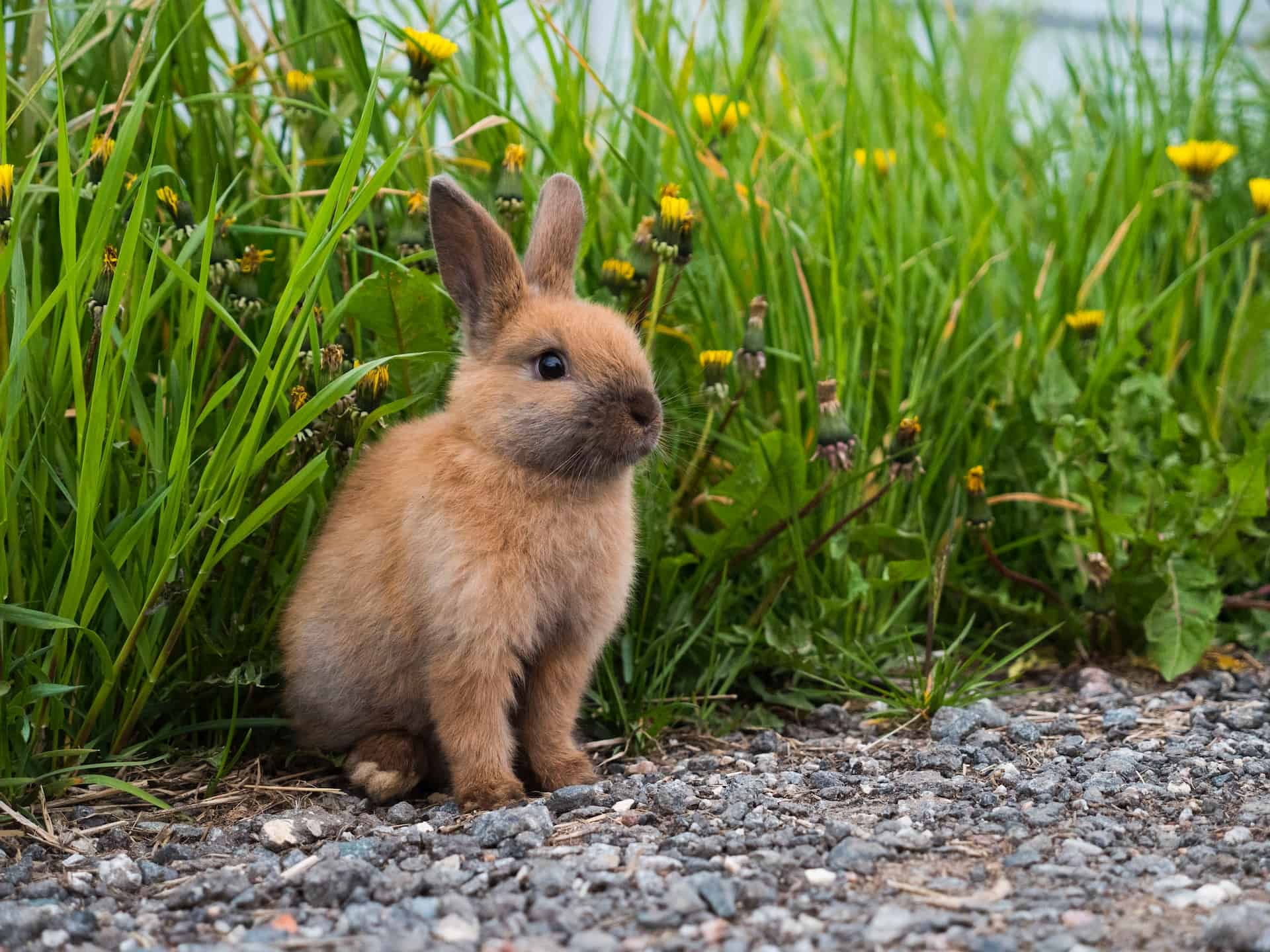| TL;DR: Rabbits are excellent jumpers and can effortlessly soar up to 2 ft off the ground in a single leap. The Guinness World Record for the highest rabbit jump currently stands at 3 ft, but there are reports of rabbits leaping over four feet. |
Rabbits are natural hoppers. With their powerful hind legs, they can leap forward with impressive force, covering great distances in a single bound.
It’s a sight to watch bunnies bounce around with their adorable hops, but have you ever wondered how high they can jump?
This article will examine this remarkable ability and explore what makes these furry creatures such skilled jumpers.
So, buckle up and let’s hop right in!
Why Do Rabbits Jump?
Rabbits’ anatomy is like a jumping engine. They have some of the most powerful muscles in the animal kingdom — 29% more powerful than those of a cheetah!
Their light weighted skeleton also makes them incredibly agile. As a result, a regular bunny can leap up to a meter from a stationary position and cover up to 10 ft in a single bound.
But before getting into how high rabbits can jump, let’s understand why they do it. There are three primary reasons bunnies engage in this behavior:
???? Reason 1: To escape from predators
Although rabbits are low on the food chain, they have evolved to possess the necessary tools and skills to survive. Their best defense against predators is evading them at full speed.
Rabbits are speedy runners — in the wild, they can reach top speeds of nearly 30 MPH— and will leap and jump in different directions to confuse and outsmart their predators in the run.
???? Reason 2: To communicate with other rabbits
Bunnies are highly social animals and frequently jump and leap over each other. These behaviors can have very different meanings; deciphering their intentions requires careful observation.
It can be a part of a mating ritual, known as cavorting, or it may simply be a way for bunnies to show affection.
On the other hand, it can also be a sign of aggression or an attempt to assert dominance. In colonies, rabbits establish a hierarchy based on strength and the bunny that jumps the farthest and highest often emerges as the pack’s leader.
???? Reason 3: To express joy
A binky is the ultimate bunny happiness and euphoria display. It is bunnies doing hops and twists in the air, sometimes even kicking their feet, flicking their heads, or flopping their ears. Seeing a rabbit binky is seeing their personality shine.
Binkies are more prevalent in younger bunnies; seniors don’t do as many — just like humans, they will become more sedentary as they age.
How High Can Rabbits Jump?
On average, rabbits can soar up to 2 ft high with ease.
However, as with most animals, their instincts and survival mechanisms are enhanced in the wild. And bunnies are no exception; wild rabbits can jump higher and farther than domesticated ones.
When escaping predators, a wild bunny can cover almost 15 feet (4 ft vertically and 9 ft horizontally) in a single leap!
| ????World Record According to the Guinness World Records, the highest recorded rabbit jump is a jaw-dropping 3.2 ft leap. The Danish rabbit Mimrelunds Tösen broke the record during an official Rabbit High Jump Competition. There is also a Guinness World Record for the longest rabbit jump set in nine feet and 9.6 inches. Yabo, another Danish rabbit, achieved it in 1999. Danish bunnies do know their way around a good jump! |
Baby Rabbits Jump Too
Kits can jump up to 2 feet high by the time they reach 3 months of age. These little hoppers are troublemakers, so you must be extra cautious.
They are incredibly fragile too, so if tempted to lift a baby bunny — who wouldn’t, right? — always make sure you’re sitting on the ground first. This way, if they decide to jump from your arms, there’s no risk of harm from a fall.
Jumping or slipping from humans’ arms is a common cause of injuries for rabbits, regardless of age. And it can be easily avoided by not picking them up if they don’t enjoy being lifted from the ground.
A Case for Bunny-Proofing Your Home
Rabbits are curious by nature. The more secure they feel, the more likely they will explore their surroundings. Your bunny will no doubt be jumping on and off beds, chairs, tables, staircases, you name it.
Bunny-proofing your home will prevent potential accidents. This includes covering or removing any dangerous items to chew or play with and removing breakable objects that could harm them if they jump on or off furniture.
Additionally, rabbits have delicate skeletons that can be deterred by excessive jumping and landing. To protect your rabbit’s health, it’s essential to provide an environment where they can choose when to jump and avoid forcing them to leap to reach their favorite spots or to jump off high places.
How to Build a Rabbit Fence
We have learned pet bunnies can jump their fair share, which can be troublesome when keeping them inside their enclosures. To avoid bunny breakouts, it is crucial to consider a few key factors when setting up a fence:
???? All fences should be at least 3 to 4” high.
???? If you plan to place a fence in the garden, it should also go 6” into the ground, angled towards the side the rabbits are meant to remain on. Rabbits are skilled diggers!
???? Use strong, lasting materials, such as galvanized steel wire of at least 18-gauge size. Chicken wire and plastic won’t stop your bunny from chewing its way out. Even kids can chew through plastic.
???? Choose a small mesh size, around 1” or smaller. This will prevent your bunny from wiggling its way past the fence.
???? If you’re looking for a more flexible option, playpens can also be a suitable choice to keep your bunny inside while allowing them some freedom to move around.
By taking these precautions, you can keep your furry friend safe, secure and able to exercise and explore.
???? So… Do Rabbits Prefer Heights or Ground Level?
Rabbits have a complex relationship with heights. In the wild, being lifted means being captured. They also escape predators by digging tunnels and burrows as ultimate hiding places. The average bunny is more inclined to dig than climb.
However, depending on your pet rabbit’s context, environment, and personality, they may enjoy climbing to high places and even onto you to explore their surroundings from above. Safety is the most crucial consideration for rabbits in these situations; if they become frightened on a high surface, they may jump off, potentially putting themselves in harm’s way.
When startled, rabbits may not be able to accurately judge the drop’s height or the landing surface’s safety.
| Pro tip: If your rabbit likes heights, you can provide climbing toys such as ramps or steps and see how they react. Start with a gradual incline and avoid high climbing devices. Also, ensure that any platform you provide has a large enough surface area for your bunny to use safely. |
Final Thoughts
Rabbits possess a remarkable anatomy that makes them excellent jumpers. However, it’s important never to force your rabbit to jump if they’re uncomfortable doing so. Forcing them to jump can result in injuries and long-term damage.
Just like us, rabbits are unique individuals with their own preferences and limits. By respecting and understanding these differences, we can ensure a happy and healthy life for our bunnies and even see them do their wonderful binkies as they play and explore their surroundings joyfully!
| SOURCES Bradford, A. (2022). Rabbits: Habits, diet & other facts. livescience.com Brown, S. (2014). Rabbit Care. veterinarypartner.vin.com House Rabbit Society (2013). Living with a house rabbit. rabbit.org Logan, S. (2022). 5 Reasons Why Rabbits Jumping Over Each Other? thebunnyhub.com One Kind Planet (2023). European Rabbit. onekindplanet.org West, T.G.et al. (2015). Power output of skinned skeletal muscle fibres from the cheetah (Acinonyx jubatus). ncbi.nlm.nih.gov |





